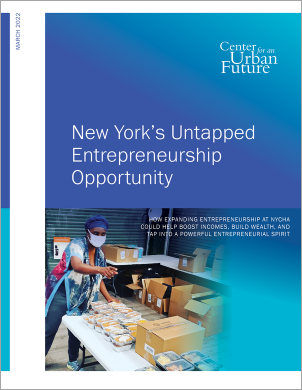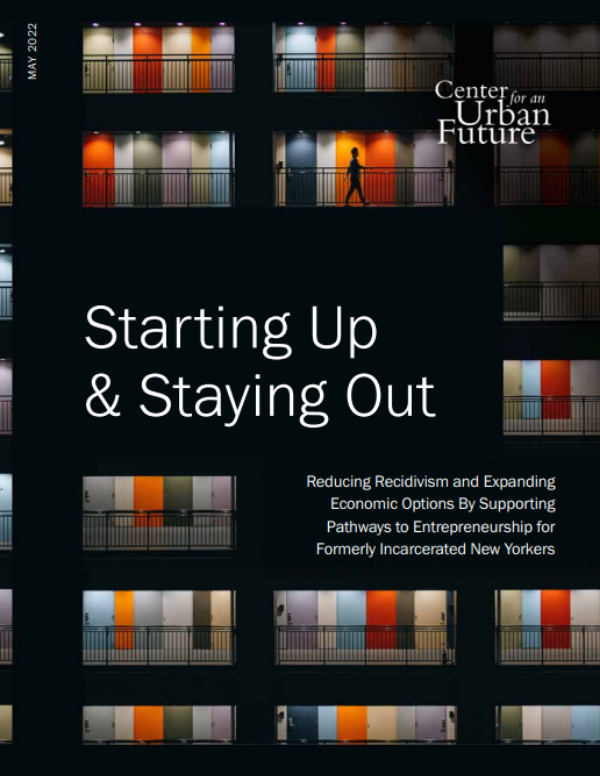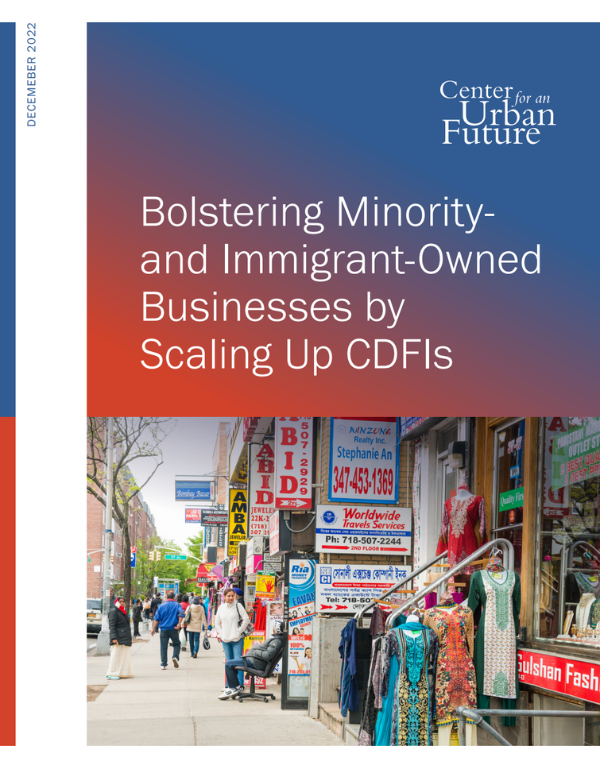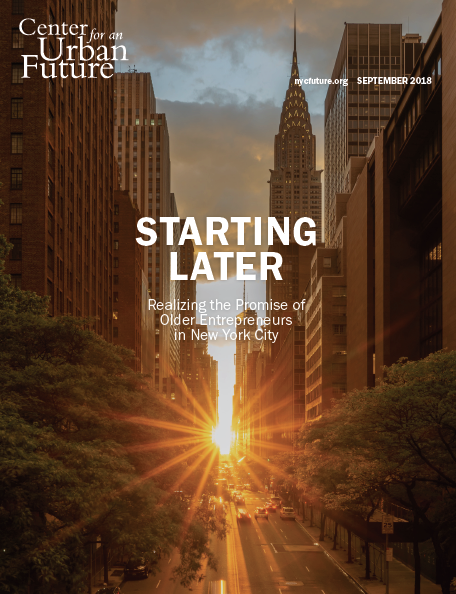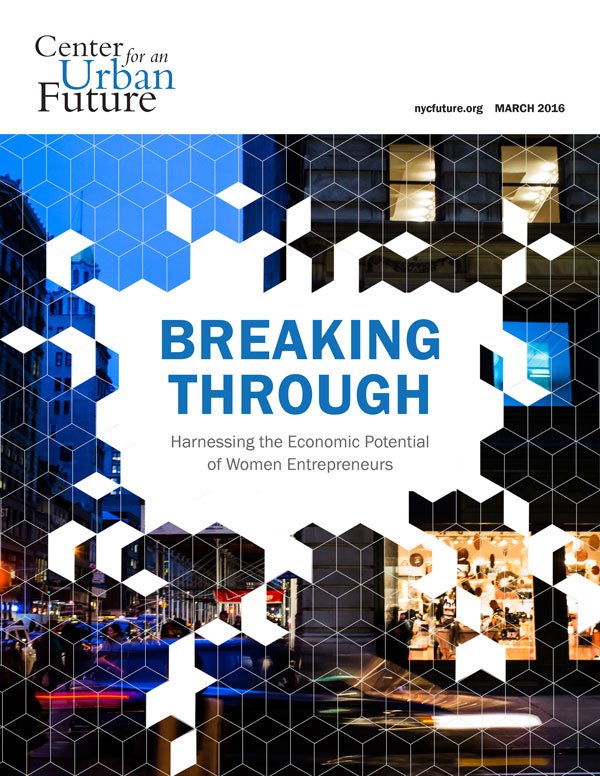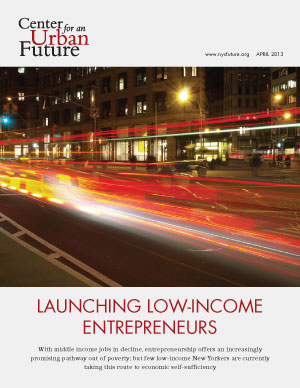Published March 29, 2022
To succeed in creating a more equitable economy in New York City, policymakers will need to help boost economic outcomes for the nearly 300,000 working-age New Yorkers living in public housing. Although new investments in workforce training and education should be part of the solution, there is also an enormous untapped opportunity to make progress by increasing rates of entrepreneurship among New York City Housing Authority (NYCHA) residents—and enabling the many public housing residents already engaged in side hustles and home-based ventures to grow their businesses.
Even before the COVID-19 pandemic hit, public housing residents faced steep barriers to economic success. In 2019, only 42 percent of working-age NYCHA residents earned income from employment, averaging just over $27,000 per year.1 These challenges have only been magnified by the pandemic. Indeed, nearly one-quarter of employed NYCHA residents worked in retail, hotels, and food—industries now lagging badly in the city’s economic recovery.2
Given the thousands of public housing residents out of work today and the longstanding barriers many face in accessing well-paying jobs, entrepreneurship could provide an alternative route for boosting incomes and building wealth. Although it may not be the best option for many residents, there is an unmistakable opportunity to strengthen this vital pathway.
In January 2021, fewer than 1 percent of NYCHA residents reported business income. But behind these low rates of formal entrepreneurship, there is promise in every NYCHA building. Countless residents earn income from a side hustle or home-based venture—including catering, party planning, fashion design, childcare, and carpentry. Meanwhile, formal entrepreneurship skyrocketed in recent years, with the number of NYCHA residents reporting business income jumping from 286 residents in 2012 to 1,636 in January 2021—a 472 percent increase.3
There are major obstacles preventing more NYCHA residents from launching businesses. This starts with limited access to capital, not surprising when so few public housing residents have personal savings or the ability to raise funds from friends and family. But there are other notable barriers, including rules that make losing government benefits—or seeing NYCHA housing costs climb—a real possibility for entrepreneurs who generate even a modest amount of income.
At the same time, little of the city’s investment in entrepreneurship has flowed to NYCHA communities. While the de Blasio administration launched the Business Pathways programs for entrepreneurs living at NYCHA, its scale remains small: fewer than 400 residents have graduated from the program since 2015. And while other city-run small business assistance programs reach tens of thousands of New Yorkers, just 496 NYCHA residents participated in them in 2019.
It’s time to tap the entrepreneurial spirit that runs through NYCHA. This report lays out a vision for how city officials can do so—empowering residents to build community wealth and helping ignite an equitable economic recovery.
This report provides a comprehensive examination of the current state of entrepreneurship among New Yorkers living in NYCHA public housing—and what it will take to increase the number of successful NYCHA resident-run businesses. Made possible by a grant from the Deutsche Bank Americas Foundation, the report builds on the Center for an Urban Future’s two decades of research about the role of entrepreneurship in building community wealth and creating a more inclusive and equitable economy in New York City, including the 2013 Launching Low-Income Entrepreneurs study.
This new report documents current self-employment among NYCHA residents, explores the benefits of fostering a robust entrepreneurial economy within NYCHA, details the obstacles that prevent larger numbers of NYCHA businesses from taking shape, and examines current supports for entrepreneurship within NYCHA. In addition, the study features best practices from across the country, and advances 15 specific, achievable policy recommendations to support entrepreneurship among New Yorkers living in public housing. It was informed by extensive data analysis and draws on interviews with more than 50 small business and microfinance experts, community development leaders, workforce development practitioners, economic development officials, entrepreneurship educators, and NYCHA entrepreneurs themselves.
With thousands of NYCHA residents currently out of work—and 500,000 fewer jobs in New York City today than prior to the pandemic—city leaders will need to support and sustain pathways to economic self-sufficiency other than employment. This report finds a significant opportunity to help more NYCHA residents embrace entrepreneurship to boost incomes and build wealth and identifies a range of supports needed to make this pathway broader and more secure.
“We have 25 to 30 percent, maybe even 35 percent, unemployment in public housing neighborhoods,” says Bishop Mitchell Taylor, CEO of Urban Upbound, a nonprofit that supports New Yorkers living in public housing. “We have to rethink how we to get those folks back to work. Business development and entrepreneurship is one of the key areas to focus on.”
With few new employment opportunities available, the months ahead may prove an ideal time for New York City to promote and support entrepreneurship among NYCHA residents. For some residents, a lack of employment opportunities or frustration with available low-wage jobs may spark interest in entrepreneurship for the very first time.
“There might be more incentive for individuals to look at entrepreneurship as a job substitute because it’s going to take quite a while for the economy to come back,” says Joyce Moy, executive director of CUNY’s Asian American/Asian Research Institute and former founding executive director of the Small Business Development Center at LaGuardia Community College. “Becoming an entrepreneur may be one of the few ways that people can, in fact, begin to bring back income to their families.”
For other residents, these same factors may prompt aspiring entrepreneurs to double down on pursuing their business ventures with the right support—whether that means launching a side hustle, taking steps toward starting a formal business or exploring ways to help a microenterprise grow. “I think this is the best time to help people see entrepreneurship as a clear and concise plan to get out of poverty,” says Connie Mendez, director of Jobs Plus at Henry Street Settlement, a workforce development program for local NYCHA residents.
In fact, some NYCHA residents are already looking to entrepreneurship as a way past unpredictable, hourly work that rarely offers chances for career advancement. But our research finds that few NYCHA residents have the means to get their business ideas off the ground on their own, despite their drive and creativity. “Low income is simply lack of money; it doesn’t mean lack of talent,” says Connie Evans, CEO of the Association for Enterprise Opportunity (AEO), which works to create economic opportunity for underserved entrepreneurs. “There are plenty of folks with ideas and talent living in public housing that have not been given the opportunity or the tools that they need to be successful in business.”
To their credit, Mayor de Blasio’s administration and NYCHA’s own Office of Resident Economic Empowerment and Sustainability (REES) made valuable strides in connecting NYCHA residents with partner organizations providing access to business education, financing, and affordable space. Since launching its first cohort in 2015, REES’s Food, Catering, and Childcare Business Pathways programs have graduated nearly 400 NYCHA entrepreneurs who have created at 243 registered businesses, including numerous food and catering businesses. In June 2021, REES and the Fund for Public Housing announced their largest single investment in boosting entrepreneurship to date: a $535,000 grant from JPMorgan Chase to help 60 residents launch their own construction businesses through intensive training programs and certification assistance.
But interest in the REES programs far exceed their capacity—more than 800 residents have interviewed for Food Business and Childcare Pathways programs, almost double the programs’ available seats—and many NYCHA entrepreneurs, especially younger residents, seek support for business plans not covered by pathways, including creative industries like fashion, music, and media.
Now it’s up to city policymakers and others to seize this interest, tap into the immense potential of aspiring NYCHA entrepreneurs, and support entrepreneurs trying to scale up and achieve profitability. “When you leave whole groups of potential entrepreneurs out of the economy, we leave out business owners and innovators. It means the entire economy is only operating on a segment of its potential,” says Nancy Carin, executive director of the Business Outreach Center Network (BOCNet), a small business development organization that works with low-income entrepreneurs. “New York City is not operating at its full potential without NYCHA entrepreneurs.”
NYCHA is full of entrepreneurial spirit—it’s just largely off the books and underrealized.
Nothing attests to the potential of NYCHA entrepre�neurship more than the informal economy thriving at NYCHA’s 335 developments across the five boroughs. “There’s an assumption that there isn’t a vibrant entrepreneurial community at NYCHA—that’s incorrect, says Alethia Mendez, division president at Grameen America, an organization that supports low-income women entrepreneurs. “It’s just that almost all of these businesses are informal and taking place out of their homes.” Indeed, our research found that the vast majority of NYCHA businesses are informal, unregistered, and often part-time operations that are impossible to track. “A lot of people in NYCHA already have businesses and side-hustles off the books. It reflects the entrepreneurial spirit, but it will never be on their tax returns,” says Colvin Grannum, CEO of Bedford-Stuyvesant Restoration Corporation, a community development organization based in Central Brooklyn. These include Shawn Sergeant, who runs a video production studio out of his Queensbridge apartment, complete with a green screen backdrop, and Alice Payne, who bakes elaborately decorated cupcakes in her Forest Houses apartment in the Bronx, which she markets via Instagram. (Given the informal nature of their businesses, these entrepreneurs spoke on the condition that they be referred to using pseudonyms.) As a consequence of the many barriers to formalization, there were only 1,636 working-age residents who reported owning their own businesses in January 2021. Even so, this represents a 472 percent increase in the number of formal entrepreneurs over the past decade, up from just 286 residents in 2012.
Support for entrepreneurship can complement workforce training— especially when jobs are scarce— but public investment is limited.
For most working NYCHA residents, hourly jobs in low wage industries and occupations are the norm. But entrepreneurship can provide an important alternative. Indeed, even in the best of times when hourly jobs were plentiful, they offered little stability or opportunities for advancement. Today the pandemic has dealt a major blow to industries like food service and retail and prompted many low-wage workers to rethink their options, leaving many NYCHA residents scrambling for alternative sources of income.
While investments in job training will be vital to ensure that more NYCHA residents can get back to work as the city’s economic recovery begins to take hold, workforce programs alone are unlikely to generate sufficient opportunities to help all those hard-hit by the pandemic. “For NYCHA residents, establishing and increasing sources of income is the fundamental need,” says Alethia Mendez of Grameen America. “This city has focused on the vocational route, and that’s been helpful. But the need has far surpassed that strategy as the only solution. There just aren’t enough opportunities for everyone on that path. People come with different interests, aptitudes, skill sets—and entrepreneurship can be the best option for many people. And it needs as much public investment, if not more, as the vocational route.”
However, given tight restrictions on how government funding for workforce development programs can be spent, very few workforce training organizations are able to offer support for entrepreneurial education and business development. Those few organizations that do support clients with entrepreneurial aspirations typically do so outside the scope of their publicly funded contracts.
“People are not getting back to work at the rates that we would like to see,” says Karen Bornarth, head of workforce at Hot Bread Kitchen, a nonprofit supporting women and emerging entrepreneurs in the city’s food industry. “For some, entrepreneurship has been a way to bring home a little bit of money each week. But in workforce development, our success is measured by job placements rather than economic stability. To really support the people we serve, we need the flexibility to think about success in different ways.”
Despite the tremendous opportunity to expand NYCHA entrepreneurship, several significant challenges stand in the way.
1. Fear of rising rents and losing housing or benefits disincentivizes entrepreneurship.
Interviews with more than two dozen resident business owners and aspiring NYCHA entrepreneurs— as well as dozens of business assistance providers and other entrepreneurship experts—surfaced a range of challenges and obstacles, from a lack of visible role models and trusted mentorship opportunities to insufficient connections with technical assistance providers. But a consensus emerged that one of the greatest challenges facing NYCHA entrepreneurs is a widespread concern about losing affordable rent and other benefits.
Economic self-sufficiency rarely comes from income alone; it flows from acquiring assets and building wealth.4 But NYCHA’s rent calculation system—as required by U.S. Department of Housing and Urban Development (HUD) rules—makes it nearly impossible to build wealth without increasing one’s cost of living, because the cash value of savings and checking accounts are included in the calculation used to determine rent each year.5 Given all the risks inherent in starting a business, it’s understandable that few NYCHA residents are willing to shoulder a rent increase simply by saving money to start a business venture—let alone by reporting self-employment income. As a result, NYCHA residents are disincentivized from starting businesses,even compared to other New Yorkers from low-wealth communities.
“There’s no winning with NYCHA,” says Aaron Prince, who runs a small construction business from his apartment in the Butler Houses in the Bronx. “The more income that you bring in your home as an entrepreneur, the more they want to raise the rent up.” Prince says that his business income varies significantly from month to month, which makes him nervous about taking on bigger jobs and then risking a rent increase.
New York City’s affordable housing crisis means that there are few if any alternatives to living in NYCHA, which encourages residents to hold fast to their apartments. The average monthly rent in NYCHA is $548—hardly enough to sublease a bedroom, let alone an apartment in most New York neighborhoods.6 As long as realistically there is nowhere else that NYCHA residents can afford to move to, these concerns are likely to continue dampening rates of entrepreneurship. And while NYCHA residents cannot lose their apartments if their income exceeds a certain amount, they can lose benefits like SNAP, Medicaid, or Supplemental Security Income (SSI).
The federal government’s Family Self Sufficiency (FSS) program can help, allowing public housing residents to save rent increases caused by rising income in an interest-bearing escrow account. But the city has done too little to market this opportunity. Just 1,274 NYCHA Section 8 residents are actively enrolled in the program—only 1.8 percent of the approximately 70,000 program participants nationwide—even though New York City is home to over 20 percent of the nation’s public housing and Section 8 residents.7 Limiting the program further, NYCHA only offers FSS to residents with Section 8 housing vouchers, although federal rules permit all public housing residents to participate.
“People are concerned that if they make money on the books, their rent will go up,” says Colvin Grannum of Bed-Stuy Restoration Corp. “No one wants to live in public housing and pay $1,800 per month—and you can’t save up enough to get out. It’s a penalty that disincentivizes entrepreneurship. And that’s true of a variety of other benefits as well.”
2. Lack of access to start-up capital prevents low-income residents from getting started.
Few NYCHA businesses have the revenue and track record to get a traditional bank loan, which generally require at least two years of operating history. And the most common source of start-up capital for entrepreneurs—friends and family loans—is simply not available to most NYCHA residents.
“Not having access to ‘friends and family’ capital is a major disadvantage,” says Nancy Carin of BOCNet. “There are two levels of obstacles. Not only do they not have access to basic capital that most entrepreneurs rely on to help start up their businesses, but not having a network of family or friends who you can talk to about business matters has a big impact when starting your own business. It is much, much harder.”
Absent this support, the vast majority of NYCHA entrepreneurs also lack the credit needed to qualify for even the smallest business loan. As a consequence, far too many NYCHA businesses are underfunded from the start or are seeded by putting start-up costs on a high-interest credit card.
“The potential for entrepreneurship among NYCHA residents is immense. The obvious obstacle is always funding,” says Gina Ramcharan, program director of the Lillian Project, a program of Harlem Business Alliance that incubates businesses owned by Black women. “People who are already struggling financially, who don’t always have the best credit, and who live in NYCHA, rarely have the assets to put up against the loan."
3. Limited mentorship opportunities and a lack of social capital inhibit entrepreneurialism.
Successful business owners often serve as crucial mentors to aspiring entrepreneurs looking to launch their own venture, but at NYCHA, with its relatively low rates of formal entrepreneurship and business income, aspiring entrepreneurs report struggling to find successful mentors who understand their challenges and experiences.
Many of the public housing–based entrepreneurs we interviewed for this report detailed the struggle to find business mentors and build relationships outside their immediate network. Others cited the fact that many developments are located in areas without strong commercial corridors, and what few businesses are located nearby are rarely if ever owned by NYCHA residents. “I constantly have to seek it out. There wasn’t anything in the community, there wasn’t anything that I’m seeing,” says NYCHA-based entrepreneur Tamykah Anthony.
“Having access to mentors and role models is a huge game-changer when it comes to entrepreneurship. It shapes the way people view their opportunity and what they think is possible,” says Robert Piercey, northeast regional director at the Network for Teaching Entrepreneurship (NFTE), a global nonprofit that teaches entrepreneurship to young people.
4. Limited government support means too little business assistance programming is effectively reaching NYCHA residents.
The same circumstances that limit NYCHA residents’ connections to potential business role models can also impact their access to small business assistance. Despite the wealth of providers and programs available to aspiring entrepreneurs in New York City, our research found that even among programs tailored to low-income New Yorkers, few were reaching New Yorkers living in public housing—often because these programs lack the outreach capacity or specific intention to target NYCHA residents.
In 2019, just 496 NYCHA residents participated in programs operated by the New York City Department of Small Business Services Business Solutions Centers out of nearly 270,000 adults living in NYCHA developments citywide. In five City Council districts with at least one NYCHA development, zero NYCHA residents used this service.8
Likewise, while NYCHA’s Business Pathways programs have had notable success, the scale of this initiative is still small: fewer than 400 NYCHA-based entrepreneurs have graduated from the program since 2015.
5. Relatively few NYCHA residents are connecting with the city's nonprofit small business assistance organizations.
Beyond NYCHA’s Business Pathways programs and its small network of business development partners, which includes Green Worker Cooperative, BOCNet, and Workshop in Business Opportunities (WIBO), business assistance for aspiring NYCHA entrepreneurs is limited. Of the fifteen nonprofit providers we interviewed for this report that provide business assistance to low-income New Yorkers, just four offer programming that regularly reaches NYCHA residents through partnerships and others forms of outreach. Few organizations have the funding or staff resources to focus on cultivating first-time entrepreneurs from the very beginning of the journey—a need that’s particularly acute among NYCHA residents.
“A lot of the resources being offered by small business assistance programs are for people who are already entrepreneurs, and not necessarily for new businesses,” says Quardean Lewis Allen, founder and CEO of the Youth Design Center, a creative agency that trains youth in Brownsville in technology, art, and design.
Other business assistance organizations have found that NYCHA residents aren’t seeking out their services on their own, but those organizations lack the capacity to do dedicated outreach in NYCHA developments.
“We’ve got NYCHA residents in our backyard, but we’re not seeing them coming through the door. The actual conversions of aspiring entrepreneurs into clients were few and far between,” says Alethia Mendez of Grameen America. “We needed to bring those resources to the NYCHA campus—it wasn’t enough to just say these resources exist.”
6. NYCHA residents face cost barriers and regulatory hurdles to scale up side-hustles into full-time businesses.
NYCHA residents with existing, informal businesses face unique barriers when they try to formalize and grow their side-hustle into a full-fledged opera�tion. The financial barriers to increasing inventory, hiring staff, and leasing space are clear. But often overlooked is the bureaucratic paperwork and fees, such as New York state’s archaic LLC reporting requirement. That requirement alone can cost upward of $2,000, which can make it difficult for cash-strapped NYCHA entrepreneurs to incorporate and grow beyond their immediate community.
Even NYCHA-sponsored programs have been hampered by regulatory issues. A promising pilot that enabled NYCHA Food Business Pathways graduates to set up shop at a kiosk in the Brooklyn Navy Yard saw NYCHA entrepreneurs earn an average of $7,815 a month, much more than typical NYCHA businesses.9 But despite committed funding and public-private support, the program had to shut down after just seven months amid licensing issues raised by the Department of Health.
Entrepreneurship is not a pathway to economic empowerment that will work for every NYCHA resident eager for a shot at greater opportunity. Starting a business is an inherently risky endeavor—just 52 percent of businesses started in New York survive the first five years, and over 20 percent fail in the first year alone.10 But for many the New Yorkers living in public housing who aspire to start a business, entrepreneurship should be a viable option. Our research has made clear that there is no shortage of creativity, industry, and entrepreneurial ambition within the city’s 335 NYCHA developments, but more must be done to ensure that first-time entrepreneurs living in public housing have the tools and resources they need to succeed.
Mayor Eric Adams and the City Council should take strong steps to support this vital but under-resourced pathway to economic self-sufficiency. City leaders should set an ambitious goal of sparking and supporting 2,500 NYCHA entrepreneurs over the next five years and back it up with a $10 million investment.
Specific ideas include kickstarting the transformation of side hustles into full-time businesses with a high profile start-up competition; helping residents save by dramatically expanding enrollment in the underused Family Self-Sufficiency Program; launching new Business Pathways programs in the creative industries; providing microgrants to boost business formation and expand participation in fairs, markets, and other growth opportunities; directing the city’s Economic Development Corporation to launch Community Kitchen Incubators in all five boroughs; funding and strengthening partnerships with local small business development organizations; leveraging vacant commercial spaces for NYCHA entrepreneurs to expand beyond their homes; investing in the creation of NYCHA worker cooperatives; and creating a NYCHA Business Credit Fund to expand access to capital to underserved NYCHA residents.
“For NYCHA residents in particular, it is important to start a business—this is the only way they’re going to be able to create wealth for their families, generational wealth,” says Camille Newman-Alleyne, director of the Women’s Business Center at East New York LDC. “It’s the key to getting out of poverty.”
This report outlines the way forward to expand pathways to entrepreneurship among NYCHA residents and help transform hustle and determination into personal and community wealth.
Endnotes
- Data from the annual income recertification conducted by the New York City Housing Authority (NYCHA), 2021.
- Share of NYCHA residents employed by industry from “NYCHA’s Crisis: A Matter for All New Yorkers,” Regional Plan Association, December 2018.
- CUF analysis of data from the New York City Housing Authority, January 2021. Our research suggests that far more residents participate in entrepreneurial activities than are captured in this data, which requires residents to report their own business income during NYCHA’s mandatory annual income recertification process. However, these figures likely include a significant share of residents with incorporated businesses.
- Joyce Klein, Bridging the Divide, FIELD at the Aspen Institute, January 2017. https://www.aspeninstitute.org/wp-content/uploads/2017/01/Briding-the-Divide.pdf
- “Public Housing Rent Calculation Frequently Asked Questions,” New York City Housing Authority. https://www1.nyc.gov/assets/nycha/downloads/pdf/Rent-Calculation-FAQ.pdf
- “NYCHA 2020 Fact Sheet,” New York City Housing Authority, March 2020. https://www1.nyc.gov/assets/nycha/downloads/pdf/NYCHA-Fact-Sheet_2020_Final.pdf
- Center for an Urban Future analysis of data from the U.S. Department of Housing and Urban Development and NYCHA.
- CUF analysis of NYC Small Businsess Services, NYC Business Solutions for NYCHA Residents by City Council District - - Local Law 163, data set, August 2020
- REES program data provided by Shana Castillo, Director, Office of Resident Economic Empowerment & Sustainability, New York City Housing Authority
- CUF analysis of data on private sector establishment survival rates from the Bureau of Labor Statistics. Available at https://www.bls.gov/bdm/ny_age_total_table7.txt
Published March 29, 2022

